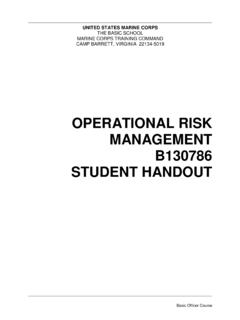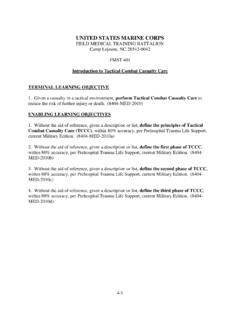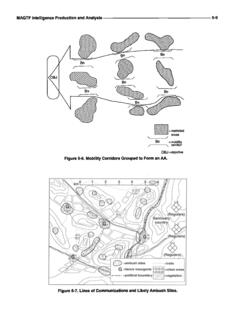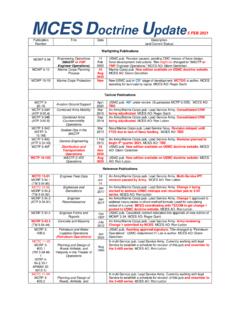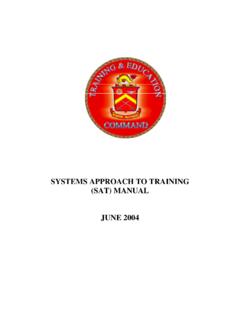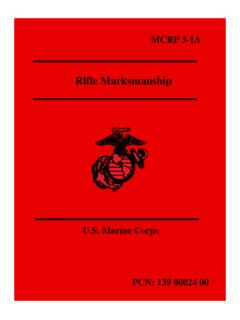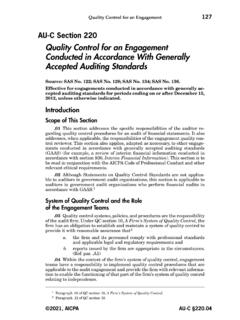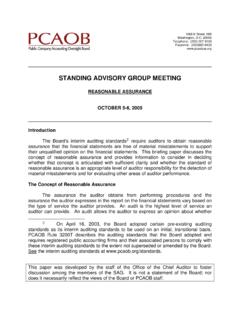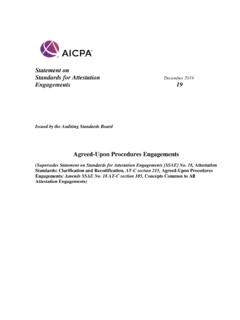Transcription of LAW OF WAR/ INTRODUCTION TO RULES OF ENGAGEMENT …
1 UNITED STATES MARINE CORPS THE BASIC SCHOOL MARINE CORPS TRAINING COMMAND CAMP BARRETT, VIRGINIA 22134-5019 LAW OF WAR/ INTRODUCTION TO RULES OF ENGAGEMENT B130936 STUDENT HANDOUT Basic Officer Course B130936 Law of War/ INTRODUCTION to RULES of ENGAGEMENT 2 Basic Officer Course Law of War/ INTRODUCTION to RULES of ENGAGEMENT INTRODUCTION The Law of War is defined as that part of international law that governs the conduct of armed hostilities. Included in this lesson are the principles underlying the Law of War, as well as classification of persons that may be found on the battlefield. The Law of War is often referred to as the law of armed conflict (LOAC). The two terms are interchangeable. The RULES of ENGAGEMENT (ROE) are those directives that delineate the circumstances and limitations under which United States (US) forces will initiate and/or continue combat ENGAGEMENT .
2 Importance The importance of understanding the Law of War in the current operational environment cannot be overstressed. All we need to do is look at one of the several cases where questionable actions have been publicly showcased to understand its importance. It is imperative that we as leaders not only know what the Law of War is, but we also have the ability to conceptualize these principles and train our Marines to the same standards. In This Lesson Discussed here will be the Law of War, ROE, training our Marines, and the impact effectively conveying the tenets and principles of the Law of War and ROE can have on a unit. This lesson covers the following topics: Topic Page Evolution of the Law of War 4 Principles of the Law of War 4 Classifications of Persons 6 Weapons and the Law of War 8 Tactics and the Law of War 10 Implications and Training Marines 10 RULES of ENGAGEMENT 13 Purposes of RULES of ENGAGEMENT 13 RULES of ENGAGEMENT and National Security 14 Standing RULES of ENGAGEMENT for US Forces 15 Training 23 Supplemental RULES of ENGAGEMENT Card 24 Summary 24 References 26 Glossary of Terms and Acronyms 27 Notes B130936 Law of War/ INTRODUCTION to RULES of ENGAGEMENT 3 Basic Officer Course Law of War/ INTRODUCTION to RULES of ENGAGEMENT (Continued)
3 Learning Objectives Terminal Learning Objectives TBS-UCMJ-1003 Without the aid of reference, describe the Law of War, without omitting key components TBS-UCMJ-2102 Without the aid of references, describe RULES of ENGAGEMENT without omission Enabling Learning Objectives TBS-UCMJ-1003a Without the aid of references, describe the origins of the Law of War without omission TBS-UCMJ-1003b Without the aid of references, describe Law of Armed Conflict principles without TBS-UCMJ-1003c Without the aid of references, describe protections afforded to personnel under the Law of War without omission. TBS-UCMJ-1003d Without the aid of references, describe classification of persons on the battlefield without omission. TBS-UCMJ-1003e Without the aid of references, describe the Department of Defense nine RULES of the Law of Armed Conflict without omission TBS-UCMJ-2101aWithout the aid of references, describe escalation of force in self/unit defense without omissionB130936 Law of War/ INTRODUCTION to RULES of ENGAGEMENT 4 Basic Officer Course Evolution of the Law of War Definition and Purpose According to Joint Chiefs of Staff (JCS) Publication (Pub) 1, the Law of War is defined as that part of war that regulates the conduct of armed hostilities.
4 The purpose of the Law of War is to prevent unnecessary suffering, safeguard certain fundamental human rights of those involved in a conflict, and to ultimately restore peace. Evolution and Development During the late middle ages, war became a cultural event studied from both political and philosophical perspectives. Leaders around the world began to realize that unlimited warfare was counterproductive to most objectives. Common customary practices started to become internationally accepted acts. Some examples include formal declarations of war, prisoner exchanges, protection of civilians and noncombatants, and communication between warring factions by neutral third parties. Some common historical examples of this progression include the Hague Convention of 1907 and the better-known Geneva Conventions of 1949.
5 Some of the outcomes of the Geneva Convention include the protection of the sick and wounded during land conflict and at sea, treatment of prisoners of war, and protection of civilians during time of war. Again, several of the laws and regulations that we abide by today have been developed from international customary practices that have eventually become codified to international law. Principles of the Law of War Military Necessity The principle of military necessity justifies the employment of violence to obtain the submission of the enemy or to reach that certain military objective. However, the actions against the enemy or the objective must not violate the Law of War. Military necessity is based upon nature, location, purpose and use. This is the guiding principle for all of our actions while operating in combat.
6 Once military necessity dictates that we engage, we must do so but in conjunction with the following principles. B130936 Law of War/ INTRODUCTION to RULES of ENGAGEMENT 5 Basic Officer Course Principles of the Law of War (Continued) Proportionality Proportionality states that the nature, duration, and scope of the ENGAGEMENT must not exceed that which is required to decisively counter the hostile act or the demonstrated hostile intent. We reply with only as much force as needed to eliminate our enemy. If a unit is pinned by a bunkered sniper, is .50-caliber or MK19 fire a proportionate retaliation? Yes, it is. An equivalent retaliation such as rifle-fire may not have been sufficient to eliminate the danger to our Marines. Either of those weapons would provide the quickest and most decisive way to neutralize the threat.
7 Now, in the same respect, a 1000-pound bomb may be seen as a disproportionate response to an improvised explosive device (IED) triggerman when a rifle shot would eliminate the threat. Avoid Unnecessary Suffering Suffering will never be eliminated from war. What we must ensure is that our decisions and actions minimize unnecessary suffering to the enemy as well as to any civilians and noncombatants involved. This includes the proportionate destruction of property that is relevant to the mission. All of our actions during the ENGAGEMENT as well as our subsequent interaction with the enemy and noncombatants should be guided by this principle. Distinction The concept of distinction requires that combatants be distinguished from noncombatants and that military objectives be distinguished from protected places.
8 Parties to a conflict are required to direct their operations only against combatants and military objectives and will be discriminate in nature. B130936 Law of War/ INTRODUCTION to RULES of ENGAGEMENT 6 Basic Officer Course Classification of Persons on the Battlefield Combatants Combatants are defined as those who are lawfully entitled to engage in hostilities. These include: Members of the armed forces. Members of a regular militia or volunteer units. Members of guerrilla units. Levee en Masse (members of a non-occupied nation who take up arms against an enemy). Characteristics of a combatant include: Wearing of a fixed and distinct uniform. Open carriage of arms. Acting under the command of a responsible leader. Obeying the Law of War. Combatants are protected under the Law of War.
9 Noncombatants Noncombatants are those who may accompany combatants but do not perform in that capacity. Examples of noncombatants include: Correspondents. Technical personnel. Contractors. Medical personnel. Chaplains. Other civilians. The Law of War states that these persons may not be the sole subjects of an attack, and warring parties must minimize damage to any noncombatant or civilian population involved. Noncombatants are also protected under the Law of War. Spies Spies are defined as those who act under false pretenses in order to obtain information and communicate that information back to a hostile or potentially hostile party. Spying is not a violation of the Law of War, but agents captured are prosecutable under the laws of the nation in which they are captured.
10 Spies are not a protected party under the Law of War. B130936 Law of War/ INTRODUCTION to RULES of ENGAGEMENT 7 Basic Officer Course Classification of Persons on the Battlefield (Continued) Terrorists, Insurgents, Saboteurs, Partisans Whether it is an individual terrorist initiating a car bomb in the West Bank or a cell of insurgents operating within Iraq, these groups are not protected by the Law of War. The only exception to this rule is if the parties act in line with the definition of a protected combatant, they must: Wear a distinguishable or distinct uniform. Openly carry arms. Act under a distinguishable leader while they themselves operate under the Law of War. Detainees and Enemy Prisoners of War (EPWs) All persons we detain on the battlefield, regardless of their status, are treated the same.
